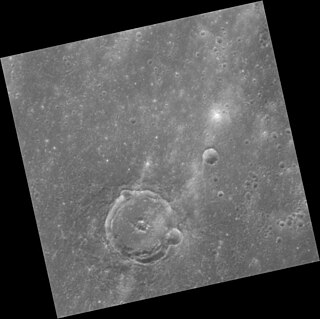
Alfonso XII, also known as El Pacificador, was King of Spain from 29 December 1874 to his death in 1885.

Antonio Canova was an Italian Neoclassical sculptor, famous for his marble sculptures. Often regarded as the greatest of the Neoclassical artists, his sculpture was inspired by the Baroque and the classical revival, and has been characterised as having avoided the melodramatics of the former, and the cold artificiality of the latter.

An impact crater is a depression in the surface of a solid astronomical body formed by the hypervelocity impact of a smaller object. In contrast to volcanic craters, which result from explosion or internal collapse, impact craters typically have raised rims and floors that are lower in elevation than the surrounding terrain. Impact craters are typically circular, though they can be elliptical in shape or even irregular due to events such as landslides. Impact craters range in size from microscopic craters seen on lunar rocks returned by the Apollo Program to simple bowl-shaped depressions and vast, complex, multi-ringed impact basins. Meteor Crater is a well-known example of a small impact crater on Earth.
Endymion primarily refers to:

The Chicxulub crater is an impact crater buried underneath the Yucatán Peninsula in Mexico. Its center is offshore, but the crater is named after the onshore community of Chicxulub Pueblo. It was formed slightly over 66 million years ago when an asteroid, about ten kilometers in diameter, struck Earth. The crater is estimated to be 200 kilometers in diameter and 1 kilometer in depth. It is believed to be the second largest impact structure on Earth, and the only one whose peak ring is intact and directly accessible for scientific research.

Diana Canova is an American actress, director, and professor. She is best known for her role as Corinne Tate on Soap (1977-1980).

Antonio Cánovas del Castillo was a Spanish politician and historian known principally for serving six terms as Prime Minister and his overarching role as "architect" of the regime that ensued with the 1874 restoration of the Bourbon monarchy. He was assassinated by anarchist, Michele Angiolillo.

Judy Canova, born Juliette Canova, was an American comedienne, actress, singer and radio personality who appeared on Broadway and in films. She hosted her own self-titled network radio program, a popular series broadcast from 1943 to 1955.

Possagno is a comune in the Province of Treviso, in the Italian region Veneto. It is located about 60 kilometres (37 mi) northwest of Venice and about 35 kilometres (22 mi) northwest of Treviso. As of 31 August 2021, it had a population of 2,215 and an area of 12.1 square kilometres (4.7 sq mi).

Psyche Revived by Cupid's Kiss is a sculpture by Italian artist Antonio Canova first commissioned in 1787 by Colonel John Campbell. It is regarded as a masterpiece of Neoclassical sculpture, but shows the mythological lovers at a moment of great emotion, characteristic of the emerging movement of Romanticism. It represents the god Cupid in the height of love and tenderness, immediately after awakening the lifeless Psyche with a kiss. The story of Cupid and Psyche is taken from Lucius Apuleius' Latin novel The Golden Ass, and was popular in art.
Mahir Canova Stage is a theatre in Balgat neighborhood of Çankaya district in Ankara, Turkey. It is operated by the Turkish State Theatres. It is named in honor of theatre director Mahir Canova (1915–1993).
Giovanni Canova was an Italian fencer. He won a gold medal at the 1920 Summer Olympics and a bronze at the 1924 Summer Olympics.

The Canova Lions, located in front of the Corcoran Gallery of Art in Washington, D.C., are copies of a pair of lions sculpted by Antonio Canova in 1792 for the tomb of Pope Clement XIII in St Peter's in Rome. The originals were sculpted from marble; these were cast in bronze from molds of the originals. The pieces were installed in 1860.

Lay That Rifle Down is a 1955 American comedy film directed by Charles Lamont starring Judy Canova. It was the thirteenth and last in a series of Judy Canova films released by Republic Pictures.
Events from the year 1897 in Spain.

The WAC from Walla Walla is a 1952 American comedy film directed by William Witney and written by Arthur T. Horman. The film stars Judy Canova, Stephen Dunne, George Cleveland, June Vincent, Irene Ryan and Roy Barcroft. The film was released on October 10, 1952, by Republic Pictures.

Timothy A. Canova is an American politician and law professor specializing in banking and finance. Canova was a candidate for Florida's 23rd congressional district, unsuccessfully challenging Debbie Wasserman Schultz in the 2016 Democratic primary, and again in the 2018 general election, where he ran as an independent candidate. He later supported President Donald Trump in the 2020 presidential election.

George Washington was a life-size marble statue of George Washington, done in the style of a Roman general, by the Venetian-Italian Neoclassical sculptor Antonio Canova. Commissioned by the State of North Carolina in 1815, it was completed in 1820 and installed in the rotunda of the North Carolina State House on December 24, 1821. The building and the statue were destroyed by fire on June 21, 1831. This work was the only one created by Canova for the United States.
Hollows are a landform on the planet Mercury, discovered during the MESSENGER mission that orbited the planet from 2011 to 2015.

Piazzolla is a crater on Mercury. Its name was adopted by the International Astronomical Union (IAU) on August 13, 2024, for the Argentine tango composer and bandoneon player Astor Piazzolla, who lived from 1921 to 1992.

















